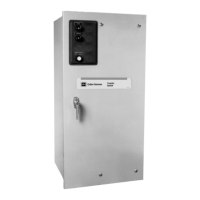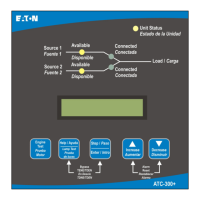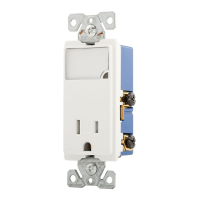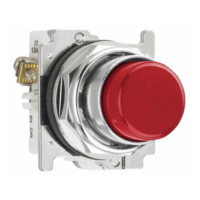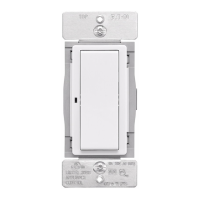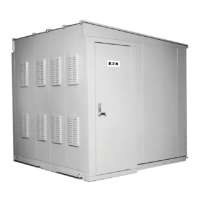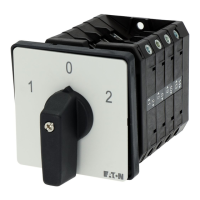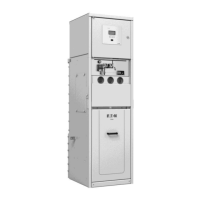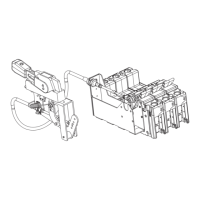IB01602008E For more information visit: www.eaton.com
Instructional Booklet
Effective: March 2014 Page 31
ATC-300 Breaker Based Transfer Switch
Figure 35.Switch Being Manually Operated (30-150 A Model).
5.4 Automatic Transfer
The operating sequence of an ATS is dictated by the switch's
standard features and selected options. Operation of an ATS dur-
ing Source 1 power source failure and Source 1 power source res-
toration will be described here with only standard options included
on the switch. Additional options, as described in Section 3, can
change sequences and timing, depending upon the options
selected. It is strongly suggested that you become familiar with
additional options selected with the particular ATS and their effect
on the normal operation of an ATS.
5.4.1 Source 1 Power Source Failure
Standard Source 1 power source failure is defined as a reduction
or loss of voltage. If this occurs, the sequence of operation is as
follows.
1. Failure of Source 1 is detected by the controller intelligence.
2. When the controller detects a failure, the engine contacts
close (after delay if programmed) and start the engine-driven
generator.
3. When the Source 2 voltage reaches its operation rating, the
K2 relay closes, starting the transfer operation. This operat-
ing sequence opens the Source 1 switch and closes the
Source 2 switch.
4. The load is now transferred to the Source 2 power source.
5.4.2 Source 1 Power Source Restoration
1. A return to the Source 1 power source begins when the volt-
age in all phases of a three-phase sensing unit, or phase-to-
phase in a single sensing unit, is restored to a preset value.
2. At the present voltage, the controller will cause the K1 relay
to change state. This starts the return to the Source 1 power
source and Source 1 transfer switch operation.
3. During this sequence, the Source 2 power source switch is
opened and the Source 1 power source switch is closed.
4. Simultaneously, the engine cool-down timer initiates the shut
down of the engine driven generator.
5. Transfer of the load back to the Source 1 power source is
now complete.
Section 6: Testing and Problem Solving
6.1 Testing
After the ATS equipment is initially installed or during planned out-
ages, the installation should be tested to ensure that all equipment
operates properly. This attention to detail will help avoid unex-
pected malfunctions. Mechanical and/or electrical tests should be
performed as described in this section.
The frequency of subsequent testing should be based on recom-
mendations of the Genset manufacturer. Use the test pushbutton
to check the electrical operation of the switch.
6.1.1 Mechanical and/or Electrical Testing
SINCE FEATURE 4 (TIME DELAY ENGINE COOL-OFF), AS DESCRIBED
IN SECTION 3, IS A STANDARD FEATURE, AN ENGINE START SIGNAL
WILL BE PRESENT FOR A PERIOD OF TIME WHEN THE SWITCH IS
FIRST ENERGIZED. THE PERIOD OF TIME IS EQUAL TO THE TIMER
SETTING. TO AVOID STARTING THE ENGINE DURING THIS TIME
PERIOD, TURN THE GENERATOR CONTROLS TO THE OFF POSITION.
Energize the ATS equipment as described in Sections 6.1.2
through 6.1.6. Insure that all safety precautions are taken and
that all WARNINGS and CAUTIONS are observed.
6.1.2 No Voltage Steps
With no voltage available on either power source, proceed as fol-
lows.
Step 1: Check to make sure that both the Source 1 and Source 2
power switching devices are in the OPEN position. The
switching devices can be put into the OPEN position
using of the manual operating handle, stopping in the
NEUTRAL position.
Step 2: The generator engine start controls should be in the OFF
position to prevent an undesired start.
Step 3: Ensure that the ATS has been set to the proper applied
system voltage (See Section 4.8).
Step 4: Check all ATS loads to ensure that they are ready to be
energized.
6.1.3 Connecting the Power Sources
Step 1: Close the Source 1 power source upstream protection
device. The Source 1 power switching device should
close
Step 2: Connect the engine start battery cable.
WARNING
HIGH VOLTAGES ASSOCIATED WITH OPERATIONAL TRANSFER
SWITCH EQUIPMENT PRESENT A SHOCK HAZARD THAT CAN
CAUSE SEVERE PERSONAL INJURY OR DEATH. USE EXTREME CAU-
TION TO AVOID TOUCHING ELECTRICAL CONNECTIONS WHENEVER
INSPECTING OR TESTING THE EQUIPMENT.
IN ADDITION, IMPROPER OPERATION OF THE GENERATOR SET
PRESENTS A HAZARD THAT CAN CAUSE SEVERE PERSONAL
INJURY OR DEATH. OBSERVE ALL SAFETY PRECAUTIONS IN YOUR
GENERATOR SET OPERATIONS AND INSTALLATION MANUALS.
NOTICE

